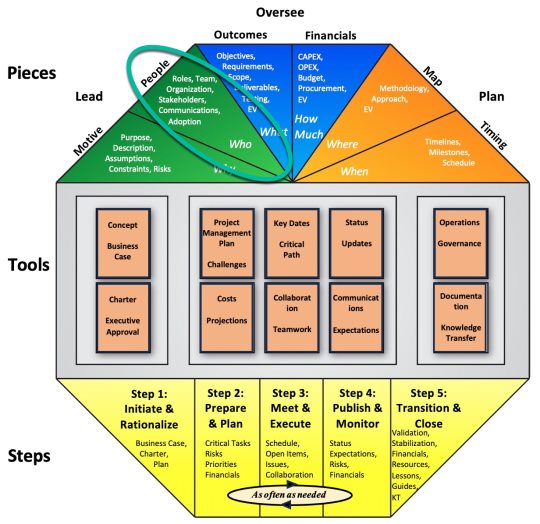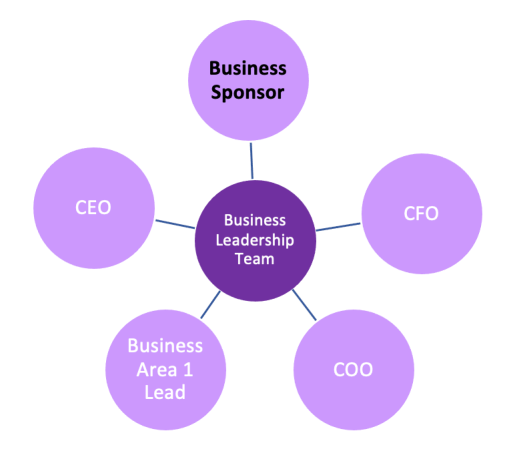An Intriguing Model of Project Communications
The purpose of this blog article is to cover how your plan is communicated and viewed using a hub and spoke model.
Communication is a piece under the LEAD domain and in the People segment in the Project Management MPM model.

Communication is a piece under the LEAD domain and in the People segment in the Project Management MPM model
Communication is Hub and Spoke
Communications of your project plan, follows a hub and spoke model.
Those closest to you, who are on your project team are the spokes in your team, as you are the hub in the project manager role.
Your team members take the message from your team meetings, and they communicate with teams they are a part of either as another spoke, or even as a hub, if it is their own team meetings. It is often these arms-length teams which are the ones that actually produce the critical deliverables for your project.
Think about what this means from a communication standpoint. Your team members are out communicating a message about the project, without you being present and are using the materials you have provided and notes they have taken.
To emphasize the challenges with this, think back to a game you may have played when you were younger, sometimes called the telephone game.
Let’s assume we have a dozen people in a circle. One person starts by whispering a single sentence into the ear of the person next to them, who relays that to the next person, and so on around the circle. Each time the sentence is whispered only once and then relayed. Eventually the message gets all the way around the circle back to the person who started it, who repeats it out loud what they were whispered and then states what the original sentence was.
The difference between the two statements is often very surprising and sometimes shocking and this game illustrates how easily a message is lost in translation as it moves from person to person.
The people on your team are like the people in the telephone game and they take whatever messages come out of the team meeting and relay that to their teams and those they work with.
The core project team has a hub and spokes
For example, in the first diagram below the core project team has two identified spokes: the Technical Team and the Business Leadership Team.

Core project team and spokes
The technical team has a hub and spokes
These each in turn have their own spokes, as the technical person returns to their appropriate teams after the meeting.

Core technical team and spokes
The business team has a hub and spokes
The businessperson is a spoke to the leadership team and represents your project in their various leadership meetings.
Core business team and spokes
Just as in the telephone game, always be asking yourself, “what message are they taking back to their teams?”. What are they saying about the project? Is there a chance for misinterpretation or misunderstanding?
And what about the message those other team spokes take back to their own teams, that are not pictured, about what needs to be done for the project?
The clearer your plan, and the clearer the deliverables, tasks and what needs to be done, the better is the result back to your project and the better is the support for your project.
Summary
Communications of your project plan, follows a hub and spoke model. Those closest to you, who are on your project team are the spokes in your team, as you are the hub in the role of project manager.
Your team members take the message from your team meetings, and they communicate with teams they are a part of either as another spoke, or even as a hub, if it is their own team meetings. It is often these arms-length teams which are the ones that actually produce the critical deliverables for your project.
The people on your team are like the people in the telephone game and they take whatever messages come out of the project meetings you hold and relay that back to their teams and those they work with, and there is always the chance for misunderstanding or misinterpretation.
The clearer your plan, and the clearer the deliverables, tasks and what needs to be done, the better is the result back to your project and the better is the support for your project.
Action Steps / Apply This Knowledge
- Think about your project team. Take 10 minutes and draw diagrams like the ones above, with your stakeholders in different hubs and spokes.
- Note which people are the spokes to other groups, such as a technical team lead, or your business sponsor. Note which people are the hubs to their own teams. Now put a check mark or ‘x’ next to the actual people who are doing the tasks for your project. They might be a couple of people removed from your team.
- Ask yourself if the message they are receiving through your plans and status reports is clear enough to ensure the best outcomes for your project. If not take some time to add clarity to your communications.
- Prompt engineering guidance for AI GPTs such as chatGPT: “I’m a business leader managing a project whose purpose is Y, and delivering X. What are some of the different teams who will be present at the project status table and what kinds of considerations do I need to be aware to take into account when creating communications for each of those teams?”
Learn More to Do More
Business evolves through change initiatives otherwise known as projects. The key to managing these change initiatives so you have more time, and less stress is to use simple strategies and tools.
Check out the Learning Hub’s other Articles with Actionable Steps, organized with a busy leader in mind, by topic or main idea, and with some AI GPT (e.g. ChatGPT) prompt engineering suggestions under the Action steps: https://simplepmstrategies.com/learning-hub-index
LEAD – Communication Hub and Spoke
© Simple PM Strategies 2024

